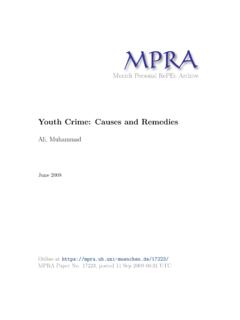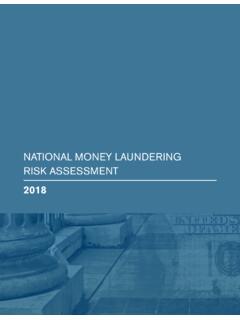Transcription of Disability and domestic abuse - GOV.UK
1 Disability and domestic abuse Risk, impacts and response Disability and domestic abuse 2 About Public Health England Public Health England exists to protect and improve the nation's health and wellbeing, and reduce health inequalities. It does this through world-class science, knowledge and intelligence, advocacy, partnerships and the delivery of specialist public health services. PHE is an operationally autonomous executive agency of the Department of Health. Public Health England Wellington House 133-155 Waterloo Road London SE1 8UG Tel: 020 7654 8000 Twitter: @PHE_uk Facebook: Prepared by: Colleen Dockerty, Dr Justin Varney, Rachel Jay-Webster The following people and organisations assisted by sharing their knowledge and expertise: Dr Sarah Woodin, Marilyn Howard, Lauren Finnegan, Clare Perkins, Sam Haskell For queries relating to this document, contact: Crown copyright 2015 You may re-use this information (excluding logos) free of charge in any format or medium, under the terms of the Open Government Licence To view this licence, visit OGL or email Where we have identified any third party copyright information you will need to obtain permission from the copyright holders concerned.
2 Published: November 2015 PHE publications gateway number: 2015498 Disability and domestic abuse 3 Contents Executive summary 4 Introduction 5 Methodology 5 Definitions 6 Limitations 7 Gender differences 8 Prevalence 9 Types of domestic abuse 10 Severity of Disability and domestic abuse 10 Risk factors and vulnerable circumstances 11 Impact of abuse 14 Responding to the challenge 15 Summary 22 Disability and domestic abuse 4 Executive summary Disabled people make up a significant minority within England: one in five of the population are Disabled people experience disproportionately higher rates of domestic abuse . They also experience domestic abuse for longer periods of time, and more severe and frequent abuse than non-disabled people. They may also experience domestic abuse in wider contexts and by greater numbers of significant others, including intimate partners, family members, personal care assistants and health care professionals.
3 Disabled people also encounter differing dynamics of domestic abuse , which may include more severe coercion, control or abuse from carers. Anybody who experiences domestic abuse may face broader risk factors, but disabled people face specific risks. They are often in particularly vulnerable circumstances that may reduce their ability to defend themselves, or to recognise, report and escape abuse . Impairment can create social isolation, which, along with the need for assistance with health and care and the potentional increased situational vulnerabilities, raises the risk of domestic abuse for disabled people. Physical and environment inaccessibility, stigma and discrimination can also exclude and isolate them. Their reliance on care increases the situational vulnerability to other people s controlling behaviour and can exacerbate difficulties in leaving an abusive situation.
4 Not only do disabled people experience higher rates of domestic abuse , they also experience more barriers to accessing support, such as health and social care services and domestic abuse services. However, services can address this by closing knowledge gaps, by improving accessibility and identification and by providing more opportunities for disclosure and support. They can do this by training health and social care professionals and staff in domestic abuse services, by improving integration of services and by engaging directly with disabled people. Disability and domestic abuse 5 Introduction This topic overview focuses on disabled people s experiences of domestic abuse . Public Health England (PHE) aims to protect and improve the population s health and reduce health inequalities.
5 As part of a broader work programme on preventing domestic abuse , PHE highlights the experiences of people enduring or affected by domestic abuse who are often ignored: this includes lesbian, gay, bisexual and trans (LGBT) people; men; black and minority ethnic (BME) people; and disabled people. This topic overview improves understanding of the complexities of disabled people s experiences of domestic abuse and promotes consideration of these complexities within the public health system . This topic overview also supports local and national action, and provides guidance to improve response across local authorities, health and social care services, clinical commissioners, domestic abuse services, Disability services, police and crime commissioners, and the wider public health system . Methodology This document highlights and outlines some of the key themes in the literature on domestic abuse and Disability to enable a reflection of and response to this issue.
6 This topic overview discusses the prevalence, risk factors and impact of domestic abuse among disabled adults in England. A systematic review of the literature was not carried out, as a search strategy with strict inclusion and exclusion criteria and critical appraisal methods was not used. The following databases were searched: Embase, Medline, British Nursing Index, CINAHL and Google Scholar. Grey literature was also searched, including the Office for National Statistics (ONS), Home Office, Women s Aid, and World Health Organization (WHO). Reference lists of key studies were also used. A combination of the following search terms was used: Disability , disabled, impairment, impaired, domestic violence, domestic abuse , intimate partner violence, sexual assault, sexual violence and rape.
7 A broad definition of Disability was used, including limitation of daily activity, chronic disease, long-term illness, congenital conditions, mental illness, dementia and cognitive, intellectual, communication, learning, sensory or physical impairments. As this topic overview focuses on the experiences of domestic abuse among disabled adults, children were excluded, UK literature was searched, along with international literature from other high-income countries. Systematic reviews and national surveys were prioritised for data on prevalence, odds ratios, risk factors and health impacts. Qualitative research was used to gain further understanding of risk factors, prevention, barriers and facilitators to accessing domestic abuse care and health care. Quotations were drawn out of the qualitative research to highlight the lived experiences of some disabled people Disability and domestic abuse 6 Definitions Impairment and Disability The meaning of the term Disability has been contested and many differing interpretations exist.
8 Definitions also differ according to self-definition, legal, administrative or funding purposes. Under the Equality Act Disability is defined as a physical or mental impairment that has a substantial and long-term adverse effect on a person s ability to do normal daily activities. Substantial refers to adverse effects that are more than minor or trivial. Long-term refers to adverse effects for longer than 12 months or that are fluctuating, recurring or The UN defines Disability as a long-term physical, mental, intellectual or sensory impairment which in interaction with various barriers may hinder their full and effective participation in society on an equal basis with others .3 WHO defines it as an umbrella term for impairments, activity limitations, and participation restrictions, the negative aspects of the interaction between individuals with a health condition and personal and environmental factors.
9 4 Two models of defining Disability are often discussed: the medical model and the social model. The medical model views a Disability as a condition that impairs an individual from living a normal and full life a condition that needs an intervention or treatment. The social model views impairment and Disability separately. According to this model, an impairment is an injury, illness, or congenital condition that causes or is likely to cause a loss or difference of physiological or psychological function, whereas Disability is a social A Disability is the interaction of the impairment with the environment, the social and physical restrictions. The way that society is organised, not the impairment itself, excludes disabled people from full participation in ,7,8 Disabled people are excluded from society by various barriers: social and cultural discrimination; negative attitudes; limited social support; inaccessible transportation, public buildings, information formats, products and built environments; inflexible organisational policies, procedures and practices; lack of services; and problems with service delivery and a lack of ,5 This topic overview ascribes to the social model and uses the terms impairment and disabled accordingly.
10 It uses the term disabled people , as opposed to people with Disability , to reflect that people may have impairments but are disabled by social factors. However, at times definitions consistent with an original source will be used and defined. Impairment is not always inherited or congenital at birth, but can be acquired throughout the life course. The proportion of adults with an impairment increases with age. Around 6% of children have an impairment, compared to 16% of working age adults and 45% of adults over state pension The point at which people acquire an impairment, at Disability and domestic abuse 7 birth or during the life course, influences how that impairment and its disabling factors impact their lives both the change itself and the experience of exclusion and The Disability sector and movement has shaped and framed the discourse on Disability .












